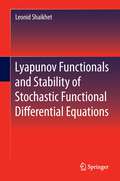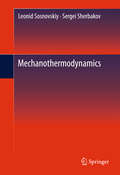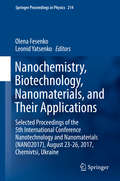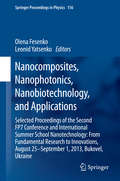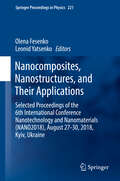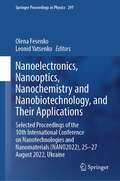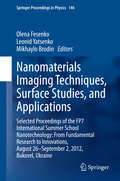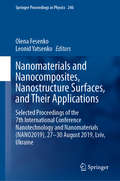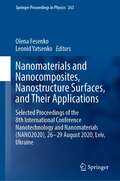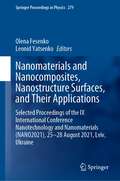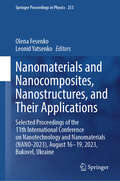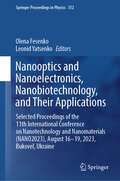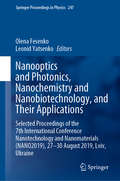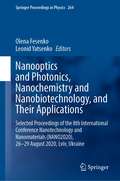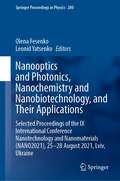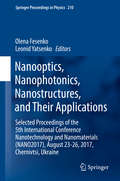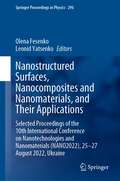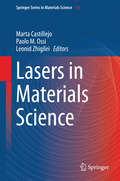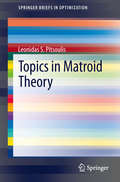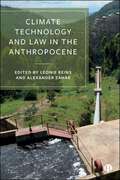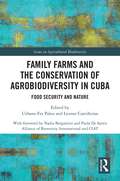- Table View
- List View
Lyapunov Functionals and Stability of Stochastic Functional Differential Equations
by Leonid ShaikhetStability conditions for functional differential equations can be obtained using Lyapunov functionals. Lyapunov Functionals and Stability of Stochastic Functional Differential Equations describes the general method of construction of Lyapunov functionals to investigate the stability of differential equations with delays. This work continues and complements the author's previous book Lyapunov Functionals and Stability of Stochastic Difference Equations, where this method is described for difference equations with discrete and continuous time. The text begins with both a description and a delineation of the peculiarities of deterministic and stochastic functional differential equations. There follows basic definitions for stability theory of stochastic hereditary systems, and the formal procedure of Lyapunov functionals construction is presented. Stability investigation is conducted for stochastic linear and nonlinear differential equations with constant and distributed delays. The proposed method is used for stability investigation of different mathematical models such as: * inverted controlled pendulum; * Nicholson's blowflies equation; * predator-prey relationships; * epidemic development; and * mathematical models that describe human behaviours related to addictions and obesity. Lyapunov Functionals and Stability of Stochastic Functional Differential Equations is primarily addressed to experts in stability theory but will also be of interest to professionals and students in pure and computational mathematics, physics, engineering, medicine, and biology.
Mechanothermodynamics
by Leonid Sosnovskiy Sergei SherbakovThis monograph addresses the foundations of mechanothermodynamics and analyzes two of its key principles--damage of everything that exists has no conceivable limits, and effective energy (entropy) flows caused by loads of a different nature do not have a cumulative property; they interact dialectically. The authors examine a generalized model of energy and entropy states of a mechanothermodynamical medium, which generally is a continuum (liquid, gaseous) containing distributed solid deformable, and, therefore, damageable bodies, as a problem of information states of movable and damageable systems and express a solution in the first approximation. The book goes on to analyze some directions of further research in its conclusion. It is ideal for scientists, engineers, post graduate and master students of mechanics, mathematics and physics.
Nanochemistry, Biotechnology, Nanomaterials, and Their Applications: Selected Proceedings of the 5th International Conference Nanotechnology and Nanomaterials (NANO2017), August 23-26, 2017, Chernivtsi, Ukraine (Springer Proceedings in Physics #214)
by Leonid Yatsenko Olena FesenkoThis book presents some of the latest achievements in nanotechnology and nanomaterials from leading researchers in Ukraine, Europe, and beyond. It features selected peer-reviewed contributions from participants in the 5th International Science and Practice Conference Nanotechnology and Nanomaterials (NANO2017) held in Chernivtsi, Ukraine on August 23-26, 2017. The International Conference was organized jointly by the Institute of Physics of the National Academy of Sciences of Ukraine, Ivan Franko National University of Lviv (Ukraine), University of Tartu (Estonia), University of Turin (Italy), and Pierre and Marie Curie University (France). Internationally recognized experts from a wide range of universities and research institutions share their knowledge and key results on topics ranging from energy storage to biomedical applications. This book's companion volume also addresses nanooptics, nanoplasmonics, and interface studies.
Nanocomposites, Nanophotonics, Nanobiotechnology, and Applications
by Leonid Yatsenko Olena FesenkoThis book presents some of the latest achievements in nanotechnology and nanomaterials from leading researchers in Ukraine, Europe, and beyond. It features contributions from participants in the 2nd International Summer School "Nanotechnology: From Fundamental Research to Innovations" and International Research and Practice Conference "Nanotechnology and Nanomaterials", NANO-2013, which were held in Bukovel, Ukraine on August 25-September 1, 2013. These events took place within the framework of the European Commission FP7 project Nanotwinning, and were organized jointly by the Institute of Physics of the National Academy of Sciences of Ukraine, University of Tartu (Estonia), University of Turin (Italy), and Pierre and Marie Curie University (France). Internationally recognized experts from a wide range of universities and research institutions share their knowledge and key results on topics ranging from nanooptics, nanoplasmonics, and interface studies to energy storage and biomedical applications.
Nanocomposites, Nanostructures, and Their Applications: Selected Proceedings of the 6th International Conference Nanotechnology and Nanomaterials (NANO2018), August 27-30, 2018, Kyiv, Ukraine (Springer Proceedings in Physics #221)
by Leonid Yatsenko Olena FesenkoThis book highlights some of the latest advances in nanotechnology and nanomaterials from leading researchers in Ukraine, Europe, and beyond. It features contributions from participants in the 6th International Science and Practice Conference Nanotechnology and Nanomaterials (NANO2018) in Kiev, Ukraine on August 27-30, 2018 organized by the Institute of Physics of the National Academy of Sciences of Ukraine, University of Tartu (Estonia), University of Turin (Italy), and Pierre and Marie Curie University (France). Internationally recognized experts from a wide range of universities and research institutions share their knowledge and key results on material properties, behavior, and synthesis. This book's companion volume also addresses topics such as nanooptics, energy storage, and biomedical applications.
Nanoelectronics, Nanooptics, Nanochemistry and Nanobiotechnology, and Their Applications: Selected Proceedings of the 10th International Conference on Nanotechnologies and Nanomaterials (NANO2022), 25–27 August 2022, Ukraine (Springer Proceedings in Physics #297)
by Leonid Yatsenko Olena FesenkoThis book highlights some of the latest advances in nanotechnology and nanomaterials from leading researchers in Ukraine, Europe and beyond. It features contributions presented at the 10th International Science and Practice Conference Nanotechnology and Nanomaterials (NANO2022), which was held on August 25-27, 2022 at Lviv House of Scientists, and was jointly organized by the Institute of Physics of the National Academy of Sciences of Ukraine, University of Tartu (Estonia), University of Turin (Italy), and Pierre and Marie Curie University (France). Internationally recognized experts from a wide range of universities and research institutions share their knowledge and key findings across diverse areas ranging from quantum optics and nanoelectonics to biophysics.The book will be interesting for leading scientists, advanced undergraduate and graduate students in nanoelectronics, optics, bio-and chemical engineering. This book’s companion volume also addresses topics such as nanostructured surface, nanomaterials, and its applications.
Nanomaterials Imaging Techniques, Surface Studies, and Applications: From Fundamental Research to Innovations, August 26-September 2, 2012, Bukovel, Ukraine
by Leonid Yatsenko Mikhaylo Brodin Olena FesenkoThis book presents cutting-edge research on a wide range of nanotechnology techniques and applications. It features contributions from scientists who participated in the International Summer School "Nanotechnology: From Fundamental Research to Innovations" in Bukovel, Ukraine on August 26 - September 2, 2012 funded by the European Commission FP7 project Nanotwinning implemented by the Institute of Physics of National Academy of Sciences of Ukraine and partner institutions: University of Tartu (Estonia), European Profiles A.E. (Greece), University of Turin (Italy) and Université Pierre et Marie Curie (France). Worldwide experts present the latest results on such key topics as microscopy of nanostructures; nanocomposites; nanostructured interfaces and surfaces; nanooptics; nanoplasmonics; and enhanced vibrational spectroscopy. Imaging technique coverage ranges from atomic force microscopy and spectroscopy, multiphoton imagery, and laser diagnostics of nanomaterials and nanostructures, to resonance Raman and SERS for surface characterization, and scanning tunneling microscopy of organic molecules. The breadth of topics highlights the exciting variety of research currently being undertaken in this field and suggests new opportunities for interdisciplinary collaboration and future research.
Nanomaterials and Nanocomposites, Nanostructure Surfaces, and Their Applications: Selected Proceedings of the 7th International Conference Nanotechnology and Nanomaterials (NANO2019), 27 – 30 August 2019, Lviv, Ukraine (Springer Proceedings in Physics #246)
by Leonid Yatsenko Olena FesenkoThis book highlights some of the latest advances in nanotechnology and nanomaterials from leading researchers in Ukraine, Europe and beyond. It features contributions presented at the 7th International Science and Practice Conference Nanotechnology and Nanomaterials (NANO2019), which was held on August 27–30, 2019 at Lviv Polytechnic National University, and was jointly organized by the Institute of Physics of the National Academy of Sciences of Ukraine, University of Tartu (Estonia), University of Turin (Italy), and Pierre and Marie Curie University (France). Internationally recognized experts from a wide range of universities and research institutions share their knowledge and key findings on material properties, behavior, and synthesis. This book’s companion volume also addresses topics such as nano-optics, energy storage, and biomedical applications.
Nanomaterials and Nanocomposites, Nanostructure Surfaces, and Their Applications: Selected Proceedings of the 8th International Conference Nanotechnology and Nanomaterials (NANO2020), 26–29 August 2020, Lviv, Ukraine (Springer Proceedings in Physics #263)
by Leonid Yatsenko Olena FesenkoThis book highlights some of the latest advances in nanotechnology and nanomaterials from leading researchers in Ukraine, Europe and beyond. It features contributions presented at the 8th International Science and Practice Conference Nanotechnology and Nanomaterials (NANO2020), which was held on August 26–29, 2020 at Lviv Polytechnic National University, and was jointly organized by the Institute of Physics of the National Academy of Sciences of Ukraine, University of Tartu (Estonia), University of Turin (Italy), and Pierre and Marie Curie University (France). Internationally recognized experts from a wide range of universities and research institutions share their knowledge and key findings on material properties, behavior, and synthesis. This book’s companion volume also addresses topics such as nano-optics, energy storage, and biomedical applications.
Nanomaterials and Nanocomposites, Nanostructure Surfaces, and Their Applications: Selected Proceedings of the IX International Conference Nanotechnology and Nanomaterials (NANO2021), 25–28 August 2021, Lviv, Ukraine (Springer Proceedings in Physics #279)
by Leonid Yatsenko Olena FesenkoThis book highlights some of the latest advances in nanotechnology and nanomaterials from leading researchers in Ukraine, Europe and beyond. It features contributions presented at the 8th International Science and Practice Conference Nanotechnology and Nanomaterials (NANO2020), which was held on August 25–28, 2021 at Lviv Polytechnic National University, and was jointly organized by the Institute of Physics, the National Academy of Sciences of Ukraine, Lviv Polytechnic National University, University of Tartu (Estonia), University of Turin (Italy), Pierre and Marie Curie University (France), European Profiles S.A. (Greece), Representation of the Polish Academy of Sciences in Kyiv, University of Angers (France), Ruprecht Karl University of Heidelberg (Germany). Internationally recognized experts from a wide range of universities and research institutions share their knowledge and key findings on material properties, behavior, and synthesis. This book’s companion volume also addresses topics such as nano-optics, energy storage, and biomedical applications.
Nanomaterials and Nanocomposites, Nanostructures, and Their Applications: Selected Proceedings of the 11th International Conference on Nanotechnology and Nanomaterials (NANO-2023), August 16-19, 2023, Bukovel, Ukraine (Springer Proceedings in Physics #253)
by Leonid Yatsenko Olena FesenkoThis book highlights some of the latest advances in nanotechnology and nanomaterials from leading researchers in Ukraine, Europe and beyond. It features contributions presented at the 11th International Conference on Nanotechnologies and Nanomaterials, and was jointly organized by the Institute of Physics of the National Academy of Sciences of Ukraine, University of Tartu (Estonia), University of Turin (Italy), and Pierre and Marie Curie University (France). Internationally recognized experts from a wide range of universities and research institutions share their knowledge and key findings on material properties, behavior, synthesis and their applications. The book will be interesting for leading scientists, advanced undergraduate and graduate students in material and nanoscience. This book’s companion volume also addresses topics such as nano-optics, nanoelectronics, energy storage and nanochemistry applications.
Nanooptics and Nanoelectronics, Nanobiotechnology, and Their Applications: Selected Proceedings of the 11th International Conference on Nanotechnology and Nanomaterials (NANO2023), August 16-19, 2023, Bukovel, Ukraine (Springer Proceedings in Physics #312)
by Leonid Yatsenko Olena FesenkoThis book highlights some of the latest advances in nanotechnology and nanomaterials from leading researchers in Ukraine, Europe, and beyond. It features contributions from participants of the 11th International Conference Nanotechnology and Nanomaterials (NANO-2023) in Bukovel, Ukraine on August 16-19, 2023 organized by the Institute of Physics of the National Academy of Sciences of Ukraine, University of Tartu (Estonia), University of Turin (Italy), and Pierre and Marie Curie University (France). Worldwide experts present scientific achievements in key topics such as nanophysics, nanophotonics, nanooptics, nanoplasmonics, nanoelectronics, and nanobiotechnology. The book explores a significant branch of nanoscience and introduces new opportunities for synergistic research. Specifically, it: • presents new methods for the synthesis and characterization of nanomaterials, nanocomposites and various nanostructures • presents microscopy, spectroscopy and laser imaging techniques for nanomaterials and nanocomposites • presents novel advances in nanophysics, nanooptics, nanophotonics, and nanoplasmonics • covers nanobiotechnology and nanochemistry, and their applications. This Book is essential reading for advanced undergraduate and graduate students, senior scientists, and industry representatives. It includes up-to-date results of investigations in nanotechnology and nanomaterials, along with promising its applications from nanophysics to nanomedicine.
Nanooptics and Photonics, Nanochemistry and Nanobiotechnology, and Their Applications: Selected Proceedings of the 7th International Conference Nanotechnology and Nanomaterials (NANO2019), 27 – 30 August 2019, Lviv, Ukraine (Springer Proceedings in Physics #247)
by Leonid Yatsenko Olena FesenkoThis book highlights some of the latest advances in nanotechnology and nanomaterials from leading researchers in Ukraine, Europe and beyond. It features contributions presented at the 7th International Science and Practice Conference Nanotechnology and Nanomaterials (NANO2019), which was held on August 27–30, 2019 at Lviv Polytechnic National University, and was jointly organized by the Institute of Physics of the National Academy of Sciences of Ukraine, University of Tartu (Estonia), University of Turin (Italy), and Pierre and Marie Curie University (France). Internationally recognized experts from a wide range of universities and research institutions share their knowledge and key findings on material properties, behavior, and synthesis. This book’s companion volume also addresses topics such as nano-optics, energy storage, and biomedical applications.
Nanooptics and Photonics, Nanochemistry and Nanobiotechnology, and Their Applications: Selected Proceedings of the 8th International Conference Nanotechnology and Nanomaterials (NANO2020), 26–29 August 2020, Lviv, Ukraine (Springer Proceedings in Physics #264)
by Leonid Yatsenko Olena FesenkoThis book highlights some of the latest advances in nanotechnology and nanomaterials from leading researchers in Ukraine, Europe and beyond. It features contributions presented at the 8th International Science and Practice Conference Nanotechnology and Nanomaterials (NANO2020), which was held on August 26–29, 2020 at Lviv Polytechnic National University, and was jointly organized by the Institute of Physics of the National Academy of Sciences of Ukraine, University of Tartu (Estonia), University of Turin (Italy), and Pierre and Marie Curie University (France). Internationally recognized experts from a wide range of universities and research institutions share their knowledge and key findings on material properties, behavior, and synthesis. This book’s companion volume also addresses topics such as nano-optics, energy storage, and biomedical applications.
Nanooptics and Photonics, Nanochemistry and Nanobiotechnology, and Their Applications: Selected Proceedings of the IX International Conference Nanotechnology and Nanomaterials (NANO2021), 25–28 August 2021, Lviv, Ukraine (Springer Proceedings in Physics #280)
by Leonid Yatsenko Olena FesenkoThis book highlights some of the latest advances in nanotechnology and nanomaterials from leading researchers in Ukraine, Europe and beyond. It features contributions presented at the 8th International Science and Practice Conference Nanotechnology and Nanomaterials (NANO2020), which was held on August 25–28, 2021 at Lviv Polytechnic National University, and was jointly organized by the Institute of Physics, the National Academy of Sciences of Ukraine, Lviv Polytechnic National University, University of Tartu (Estonia), University of Turin (Italy), Pierre and Marie Curie University (France), European Profiles S.A. (Greece), Representation of the Polish Academy of Sciences in Kyiv, University of Angers (France), Ruprecht Karl University of Heidelberg (Germany). Internationally recognized experts from a wide range of universities and research institutions share their knowledge and key findings on material properties, behavior, and synthesis. This book’s companion volume also addresses topics such as nano-optics, energy storage, and biomedical applications.
Nanooptics, Nanophotonics, Nanostructures, and Their Applications: Selected Proceedings of the 5th International Conference Nanotechnology and Nanomaterials (NANO2017), August 23-26, 2017, Chernivtsi, Ukraine (Springer Proceedings in Physics #210)
by Leonid Yatsenko Olena FesenkoThis book presents some of the latest achievements in nanotechnology and nanomaterials from leading researchers in Ukraine, Europe, and beyond. It features selected peer-reviewed contributions from participants in the 5th International Science and Practice Conference Nanotechnology and Nanomaterials (NANO2017) held in Chernivtsi, Ukraine on August 23-26, 2017. The International Conference was organized jointly by the Institute of Physics of the National Academy of Sciences of Ukraine, Ivan Franko National University of Lviv (Ukraine), University of Tartu (Estonia), University of Turin (Italy), and Pierre and Marie Curie University (France). Internationally recognized experts from a wide range of universities and research institutions share their knowledge and key results on topics ranging from nanooptics and nanoplasmonics to interface studies. This book's companion volume also addresses topics such as energy storage and biomedical applications.
Nanophotonics, Nanooptics, Nanobiotechnology, and Their Applications: Selected Proceedings of the 6th International Conference Nanotechnology and Nanomaterials (NANO2018), August 27-30, 2018, Kyiv, Ukraine (Springer Proceedings in Physics #222)
by Leonid Yatsenko Olena FesenkoThis book highlights some of the latest advances in nanotechnology and nanomaterials from leading researchers in Ukraine, Europe, and beyond. It features contributions from participants in the 6th International Science and Practice Conference Nanotechnology and Nanomaterials (NANO2018) in Kiev, Ukraine on August 27-30, 2018 organized by the Institute of Physics of the National Academy of Sciences of Ukraine, University of Tartu (Estonia), University of Turin (Italy), and Pierre and Marie Curie University (France). Internationally recognized experts from a wide range of universities and research institutions share their knowledge and key results on nanooptics, energy storage and biomedical applications. This book's companion volume also addresses topics such as materials properties, behavior, and synthesis.
Nanophysics, Nanomaterials, Interface Studies, and Applications
by Leonid Yatsenko Olena FesenkoThis book presents some of the latest achievements in nanotechnology and nanomaterials from leading researchers in Ukraine, Europe, and beyond. It features selected peer-reviewed contributions from participants in the 4th International Science and Practice Conference Nanotechnology and Nanomaterials (NANO2016) held in Lviv, Ukraine on August 24-27, 2016. The International Conference was organized jointly by the Institute of Physics of the National Academy of Sciences of Ukraine, Ivan Franko National University of Lviv (Ukraine), University of Tartu (Estonia), University of Turin (Italy), and Pierre and Marie Curie University (France). Internationally recognized experts from a wide range of universities and research institutions share their knowledge and key results on topics ranging from nanooptics, nanoplasmonics, and interface studies to energy storage and biomedical applications.
Nanophysics, Nanophotonics, Surface Studies, and Applications
by Leonid Yatsenko Olena FesenkoThis book presents some of the latest achievements in nanotechnology and nanomaterials from leading researchers in Ukraine, Europe, and beyond. It features contributions from participants in the 3rd International Science and Practice Conference Nanotechnology and Nanomaterials (NANO2015) held in Lviv, Ukraine on August 26-30, 2015. The International Conference was organized jointly by the Institute of Physics of the National Academy of Sciences of Ukraine, University of Tartu (Estonia), Ivan Franko National University of Lviv (Ukraine), University of Turin (Italy), Pierre and Marie Curie University (France), and European Profiles A. E. (Greece). Internationally recognized experts from a wide range of universities and research institutions share their knowledge and key results on topics ranging from nanooptics, nanoplasmonics, and interface studies to energy storage and biomedical applications.
Nanoplasmonics, Nano-Optics, Nanocomposites, and Surface Studies
by Leonid Yatsenko Olena FesenkoThis book highlights the most recent advances in nano science from leading researchers in Ukraine, Europe and beyond. It features contributions from participants of the 3rd International Summer School "Nanotechnology: From Fundamental Research to Innovations," held in Yaremche, Ukraine on August 23-26, 2014 and of the 2nd International NANO-2014 Conference, held in Lviv, Ukraine on August 27-30, 2014. These events took place within the framework of the European Commission FP7 project Nano twinning and were organized jointly by the Institute of Physics of the National Academy of Sciences of Ukraine, University of Tartu (Estonia), University of Turin (Italy) and Pierre and Marie Curie University (France). Internationally recognized experts from a wide range of universities and research institutions share their knowledge and key results in the areas of nanocomposites and nanomaterials, nanostructured surfaces, microscopy of nano-objects, nano-optics and nano photonics, nano plasmonics, nano chemistry, nano biotechnology and surface enhanced spectroscopy. Covers nanocomposites, nano structured surfaces and nano biotechnology Presents state-of-the-art advances in nano plasmonics, nanomaterials characterization and surface enhanced spectroscopy Represents essential reading for advanced undergraduate and graduate students through practicing university and industry researchers
Nanostructured Surfaces, Nanocomposites and Nanomaterials, and Their Applications: Selected Proceedings of the 10th International Conference on Nanotechnologies and Nanomaterials (NANO2022), 25—27 August 2022, Ukraine (Springer Proceedings in Physics #296)
by Leonid Yatsenko Olena FesenkoThis book highlights some of the latest advances in nanotechnology and nanomaterials from leading researchers in Ukraine, Europe and beyond. It features contributions presented at the 10th International Science and Practice Conference Nanotechnology and Nanomaterials (NANO2022), which was held in hybrid format on August 25-27, 2022 at Lviv House of Scientists, and was jointly organized by the Institute of Physics of the National Academy of Sciences of Ukraine, University of Tartu (Estonia), University of Turin (Italy), and Pierre and Marie Curie University (France). Internationally recognized experts from a wide range of universities and research institutions share their knowledge and key findings on material properties, behavior, synthesis and their applications.The book will be interesting for leading scientists, advanced undergraduate and graduate students in material and nanoscience. This book’s companion volume also addresses topics such as nano-optics, nanoelectronics, energy storage, nanochemistryl and biomedical applications.
Lasers in Materials Science
by Marta Castillejo Paolo M. Ossi Leonid ZhigileiThis book covers various aspects of lasers in materials science, including a comprehensive overview on basic principles of laser-materials interactions and applications enabled by pulsed laser systems. The material is organized in a coherent way, providing the reader with a harmonic architecture. While systematically covering the major current and emerging areas of lasers processing applications, the Volume provides examples of targeted modification of material properties achieved through careful control of the processing conditions and laser irradiation parameters. Special emphasis is placed on specific strategies aimed at nanoscale control of material structure and properties to match the stringent requirements of modern applications. Laser fabrication of novel nanomaterials, which expands to the domains of photonics, photovoltaics, sensing, and biomedical applications, is also discussed in the Volume. This book assembles chapters based on lectures delivered at the Venice International School on Lasers in Materials Science which was held in Isola di San Servolo, Venice, Italy, in July, 2012.
Topics in Matroid Theory
by Leonidas S. PitsoulisTopics in Matroid Theory provides a brief introduction to matroid theory with an emphasis on algorithmic consequences. Matroid theory is at the heart of combinatorial optimization and has attracted various pioneers such as Edmonds, Tutte, Cunningham and Lawler among others. Matroid theory encompasses matrices, graphs and other combinatorial entities under a common, solid algebraic framework, thereby providing the analytical tools to solve related difficult algorithmic problems. The monograph contains a rigorous axiomatic definition of matroids along with other necessary concepts such as duality, minors, connectivity and representability as demonstrated in matrices, graphs and transversals. The author also presents a deep decomposition result in matroid theory that provides a structural characterization of graphic matroids, and show how this can be extended to signed-graphic matroids, as well as the immediate algorithmic consequences.
Climate Technology and Law in the Anthropocene
by Leonie Reins and Alexander ZaharAvailable open access digitally under CC-BY-NC-ND licence. As climate change accelerates, our window for action is closing. To stay within the "Anthropocene" - an epoch in which humankind as the dominant force shaping the planet retains a degree of control over the destructive processes it has unleashed - global warming must be kept below 2° Celsius. This book explores the unprecedented technological and legal changes required to achieve this. Featuring contributions from leading experts, the essays examine the intersection of technology, law, and environmental values, offering diverse viewpoints on navigating the Anthropocene. Revealing the controversies of rapid technological adoption and legal reform, this is a crucial analysis of a complex future whose many dangers for our society are barely understood.
Family Farms and the Conservation of Agrobiodiversity in Cuba: Food Security and Nature (Issues in Agricultural Biodiversity)
by Urbano Fra Paleo Leonor CastiñeirasThis highly original volume investigates and documents the complex interactions between small family farms and Man and Biosphere Reserves in Cuba. Covering over two decades of research in agriculture and biodiversity conservation in Cuba, this book provides a unique case study about sustainable agriculture. It shows how the agricultural biodiversity maintained in situ by family farms within those protected areas provides a strategic source of crop genetic resources, including seeds and planting materials, as well as agroecological knowledge and practices. Agricultural practices within and around the Biosphere Reserves have helped to promote local food security through healthier and more diverse food production, while contributing to the conservation of biodiversity and of ecosystems. The book also reports on the adoption of transdisciplinary methods, combining ecological, agronomic, and socio-economic research, along with participatory methods involving farmers in research to document ethnobotanical and farmer knowledge, revealing rich spots of agrobiodiversity maintained in landscapes, seed systems, and nurseries managed by farmers. It covers a range of ecosystems and biocultural landscapes from arid tropics, tropical hillsides and savannas, montane rainforests, and coastal areas. It examines how family farms in diverse Cuban ecosystems use biodiversity, agro-ecological knowledge, and techniques while sustaining natural and farming landscapes in a scenario of climate change, frequent disasters, and socio-economic and policy changes. This book will be most suitable for those studying or interested in farming practices, biodiversity conservation, food security, agrobiodiversity, and sustainable development, as well as in Cuban studies.
